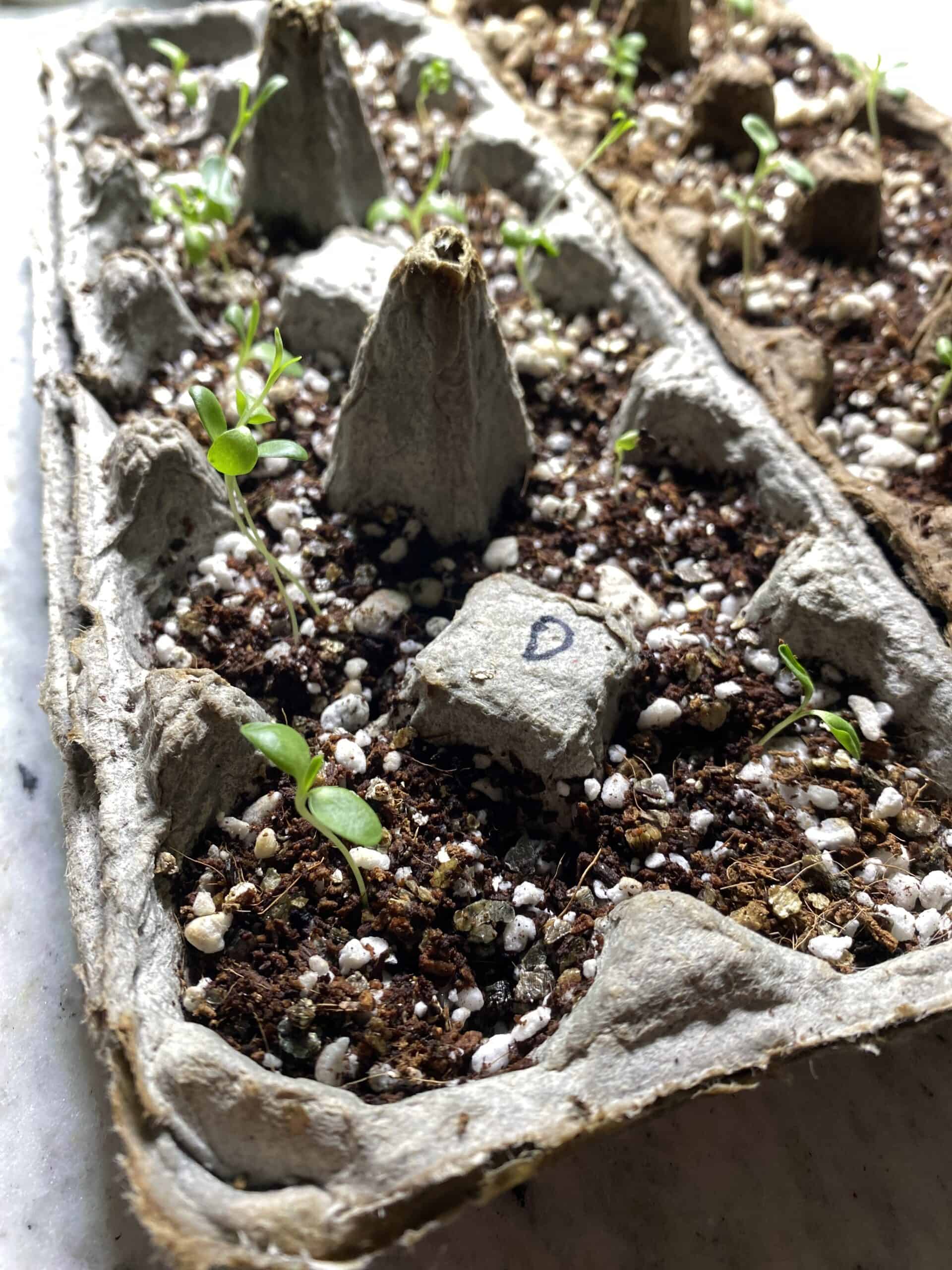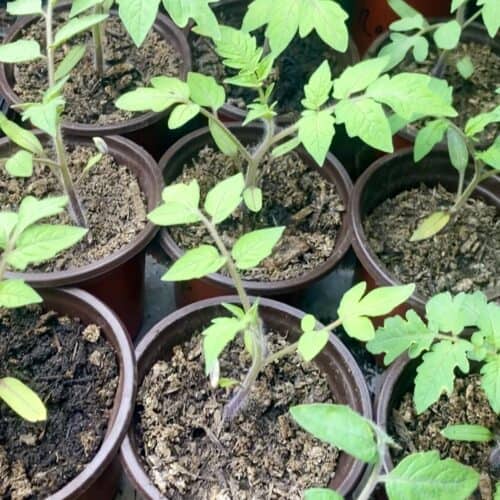This post is all about growing tomatoes for beginners!
Growing tomatoes for beginners can be intimidating but don’t let that deter you. With just a little knowledge you will know how to plant tomatoes at home and have juicy sun-ripened tomatoes in your hands in no time.
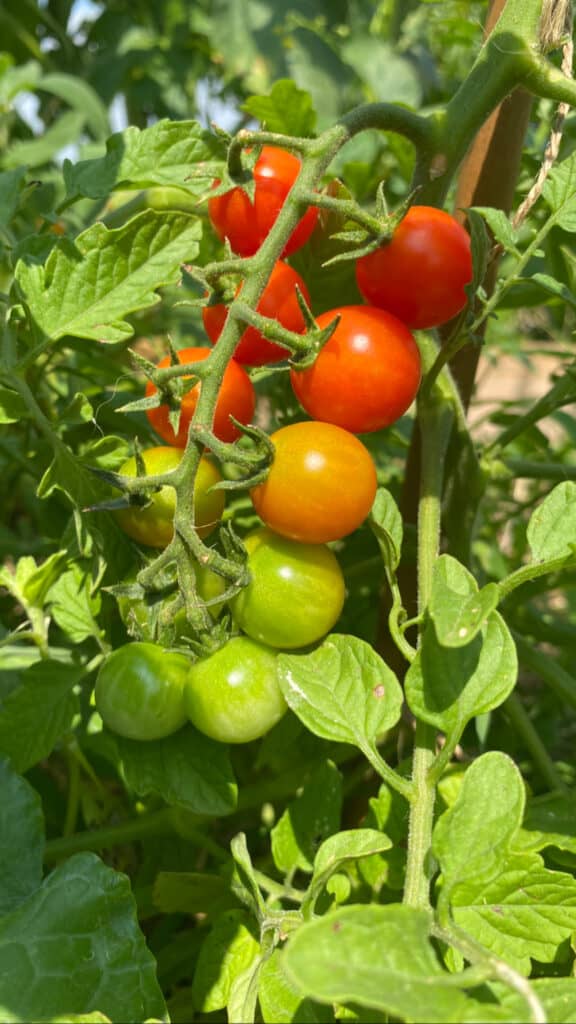
Tomatoes are one of my favorite crops to grow, from delicious sauce tomatoes to the best garden snack of a cherry tomato. There is nothing more rewarding! In this informative guide, we’ll walk you through the steps to ensure a bountiful harvest. Let’s get into some tomato growing tips!
1. Start from seeds vs. plants
When it comes to growing tomatoes for beginners it is recommend to purchase starts vs. starting from seed. If you are up for the challenge of seed starting, go for it!
As a new beginner it can be a little daunting having to worry about starting tomatoes at the right time and having a good setup indoors for doing so. To save headache you can buy tomato plants already started from the store. Stores typically have plants available right around the time it is time to plant them out in your area.
If you choose to start tomatoes from seed find out when your last frost date is. You will need to know this date because most tomatoes needs to be started 6-8 weeks before the last frost date. Tomatoes require a long growing season and this will allow a head start, giving your plants more time to mature and produce fruit .
{Related Post: What to Plant in February to Give the Garden the Boost it Needs}
2. Selecting the Right Varieties
The first step to growing tomatoes for beginners is choosing the right varieties. When deciding what varieties to grow there are two types of tomatoes to pay attention to that may dictate what you grow based on your available space. Understanding the differences between determinate and indeterminate tomatoes is key to optimizing your tomato-growing experience.
Determinate Tomatoes: The Compact Champions
Determinate tomatoes have a predetermined height and a defined lifespan. These varieties tend to grow to a specific height (Between 2-4 feet) and set fruit within a concentrated period. This makes determinate tomatoes ideal for those with limited space or looking for a quick, concentrated harvest.
The compact nature of determinate tomatoes makes them great for container gardening, small garden beds, or even patio planters.
One of the advantages is that they tend to mature earlier than indeterminate varieties. However, it’s important to note that once determinate plants have produced their fruit, they will gradually decline. I have found that they will go through another round of production if left planted but the amount won’t be as large as the first.
Popular varieties include “Bush Early Girl,” “Celebrity,” and “Roma” (ideal for making sauces and pastes).
Indeterminate Tomatoes: The Vine Enthusiasts
Indeterminate tomatoes will keep growing and producing fruit until they are stopped by external factors, such as frost. These plants have a vining nature and can reach considerable heights.
They are known for their extended harvesting period, providing a steady supply of tomatoes throughout the season. The longer production period of indeterminate tomatoes allows for a more prolonged enjoyment of homegrown tomatoes well into late summer and early fall.
While indeterminate varieties offer an extended harvest, they may require more space and attention, as their sprawling vines can take up more real estate in the garden.
Common indeterminate varieties include “Brandywine,” “Cherokee Purple,” and “Sun Gold” (a delightful cherry tomato variety).
3. The Perfect Planting Spot:
Tomatoes love sun, so choose a spot that receives at least 6-8 hours of sunlight daily. Well-draining soil is essential to prevent waterlogged roots, so incorporate organic matter to enhance soil structure. Ensure your chosen area has good air circulation to discourage diseases. If you’re tight on space, consider container gardening – tomatoes can thrive in pots on patios or balconies.
4. Planting with Care:
Once you’ve selected your tomato varieties and found the ideal spot, it’s time to get your hands dirty. Plant your tomatoes after the last frost date, when the soil has warmed up. To be on the safe side I like to wait at least a week after my last frost date and keep an eye on the weather to ensure there isn’t going to be a late frost.
Dig a hole deep enough to bury one-third of the stem. This allows the plant to develop a robust root system. Add a handful of compost or fertilizer to the hole for an extra boost of nutrients.
Make sure to water your plants in well.
5. Watering Wisdom:
Tomatoes are thirsty plants, but they’re also susceptible to diseases like blight if their foliage gets too wet.
Water consistently to keep the soil evenly moist, preferably in the morning to allow any excess moisture to evaporate during the day.
A soaker hose or drip irrigation system can be beneficial due to this, as it delivers water directly to the soil, minimizing contact with the leaves but isn’t a requirement.
6. The Art of Mulching:
Mulching is an absolute game-changer!
Spread a layer of organic mulch, such as straw or shredded leaves, around your plants to retain moisture, suppress weeds, and regulate soil temperature.
Mulch also acts as a barrier, preventing soil-borne diseases from splashing onto your plants during rain or watering.
7. Support Systems:
As your tomatoes grow, they’ll need support to prevent sprawling and to keep the fruit off the ground, reducing the risk of rot. Consider using tomato cages, stakes. or trellises to provide a sturdy framework for your plants.
Tomato cages will work well for determinate tomatoes due to their limited size. They often require less staking due to their more restrained growth habit.
Sturdy staking and trellises is often utilized for indeterminate tomatoes to support their continuous vining growth.
Regularly check for any signs of sagging or bending and make adjustments as needed to ensure your tomatoes grow tall and the branches don’t snap.
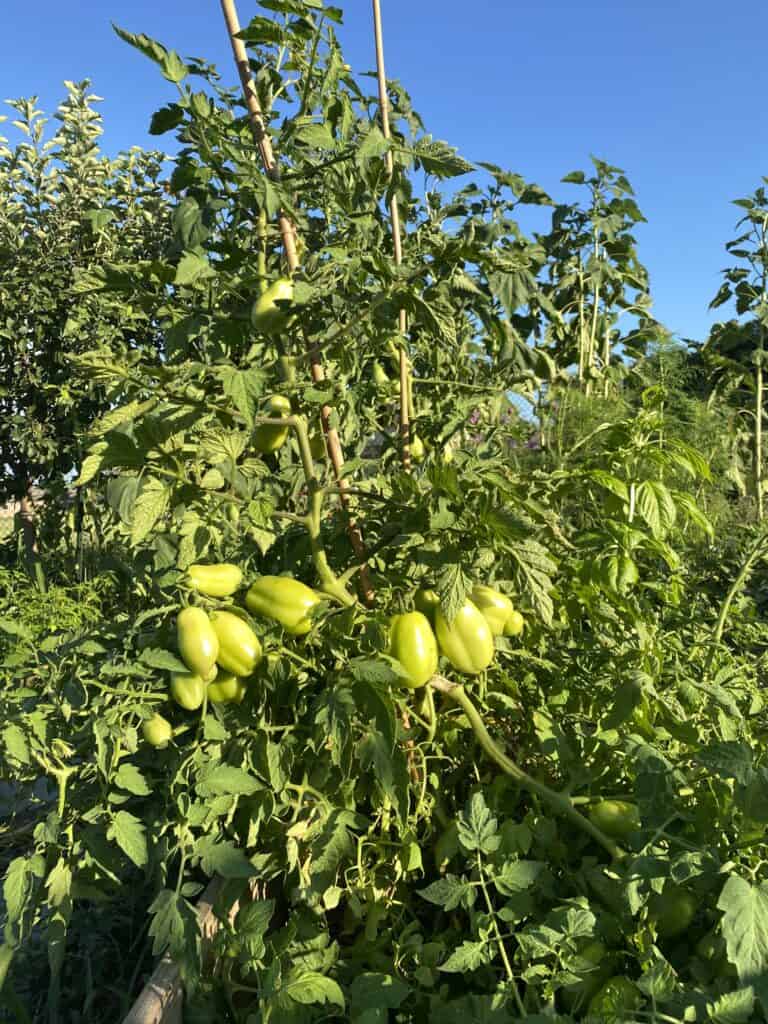
8. Feeding for Flavor:
Tomatoes are heavy feeders, meaning they require a steady supply of nutrients to produce the flavorful fruits.
Start with a balanced fertilizer at planting time, and then feed your tomatoes every 3-4 weeks throughout the growing season. Consider using a fertilizer specifically formulated for tomatoes, as they often contain the essential nutrients – nitrogen, phosphorus, and potassium – in the right proportions for optimal growth.
One of my favorite fertilizer’s from Dr. Earth
9. Pruning for Productivity:
When growing tomatoes for beginners pruning may sound intimidating, but it’s a crucial step to encourage air circulation and focus the plant’s energy on fruit production.
As the plant grows, remove some of the lower leaves that are close to the ground. This helps improve airflow and reduces the risk of soil-borne diseases splashing onto the leaves.
Keep an eye out for any yellowing or diseased leaves and promptly remove them to prevent the spread of infection.
Aside from the lower leaves, it is recommended to not prune determinate tomatoes due to the predetermined height and concentrated fruit production period as it will limit harvest quantities.
For indeterminate tomatoes regular pruning and maintenance are recommended to manage the plant’s size and encourage optimal fruit production. Some Gardeners like to Pinch off the suckers – the small shoots that form between the main stem and branches – to direct nutrients to the developing fruit.
10. Pest Patrol:
No garden is immune to pests, but with a bit of vigilance, you can keep your tomato plants healthy. Inspect your plants regularly for signs of unwanted visitors like aphids, hornworms, or spider mites.
Consider companion planting with herbs like basil or marigolds, which can act as natural repellents. If an infestation occurs, organic insecticidal soaps or neem oil can be effective, but always follow the instructions carefully to avoid harming beneficial insects.
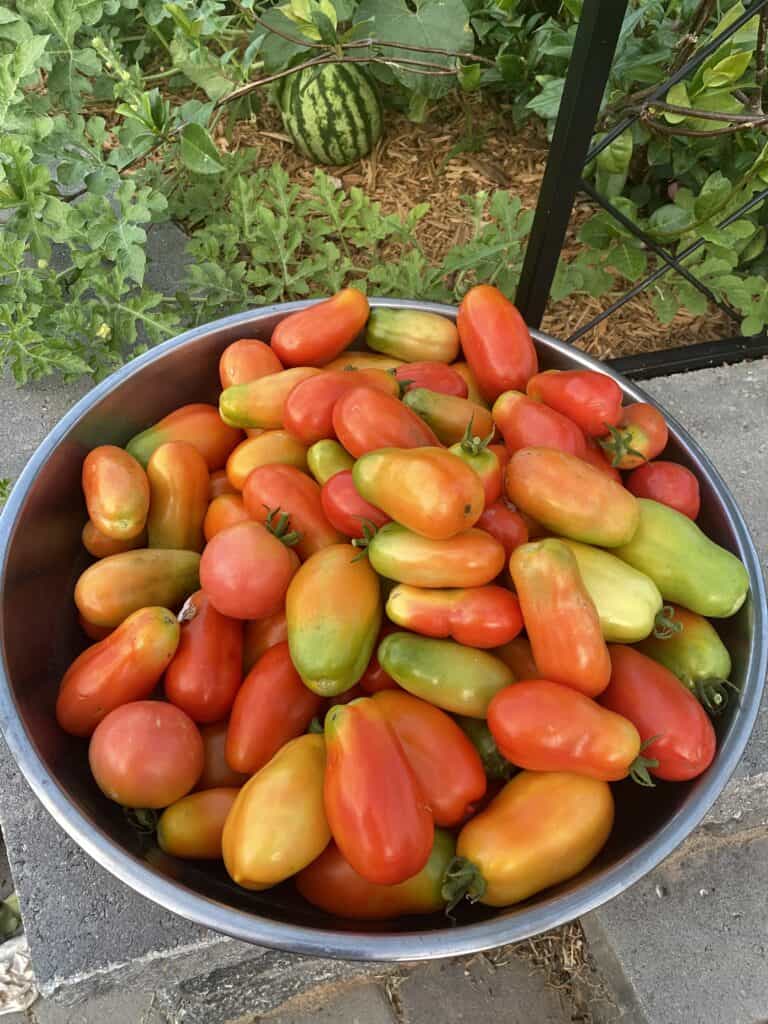
11. Harvesting Happiness:
The moment you’ve been patiently waiting for has arrived – harvest time! Pick your tomatoes when they reach their full color and are slightly soft to the touch. Gently twist or cut the fruit from the stem, being careful not to damage the plant. Tomatoes can also be picked slightly underripe, as they’ll continue to ripen off the vine.
Conclusion:
Growing tomatoes for beginners is simpler than one initially thinks, just keep in mind the tomato growing tips discussed and you will have a ripe tomato in no time. Like with everything gardening you just have to do it and learn from experience.

